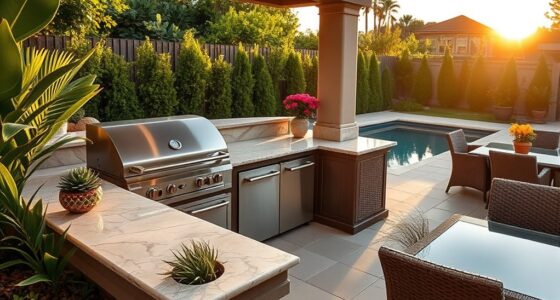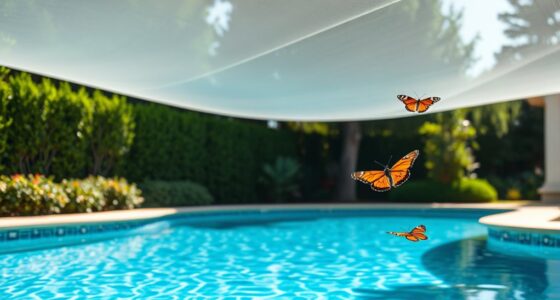Permeable pavers are an excellent choice for pool deck drainage because they allow water to quickly infiltrate the surface, reducing puddles and slip hazards. They help manage heavy rain and pool runoff while maintaining a safe, dry area around your pool. These pavers come in various materials and designs to match your style and guarantee durability. To learn more about how to optimize your pool deck with permeable pavers, keep exploring the options available.
Key Takeaways
- Permeable pavers allow water to infiltrate, reducing puddling and improving drainage around pool decks.
- Materials like concrete, porous asphalt, or interlocking pavers are suitable for effective water management.
- Proper installation ensures level surfaces and optimal slope for efficient water runoff.
- Permeable pavers help prevent erosion, pooling, and water damage, enhancing safety and durability.
- Regular maintenance maintains permeability and prevents clogging, ensuring long-term drainage performance.
How Permeable Pavers Enhance Pool Deck Safety and Comfort

Permeable pavers substantially improve pool deck safety and comfort by reducing water accumulation and preventing slippery surfaces. When rain or splashes occur, these pavers allow water to pass through quickly, keeping the surface dry and less hazardous. This drainage capability minimizes puddling, which can cause slips and falls. Additionally, permeable pavers help maintain a more consistent temperature, preventing the deck from becoming excessively hot under the sun, which enhances comfort when walking barefoot. By reducing water buildup, they also lessen the risk of mold and algae growth, further improving safety. Proper installation of permeable pavers ensures optimal drainage performance, enhancing overall safety and durability. Moreover, the use of environmentally friendly materials in permeable pavers supports sustainable stormwater management practices. Incorporating eco-friendly materials into your permeable paver system can further improve environmental benefits and durability. Using permeable pavers in combination with other landscape design elements can create a more integrated and functional outdoor space. Overall, permeable pavers create a safer, more comfortable environment around your pool, giving you peace of mind while enjoying outdoor activities.
Materials and Designs of Permeable Pavers Suitable for Pools

Choosing the right materials and designs for permeable pavers is essential to guarantee durability and aesthetic appeal around your pool. You’ll want options that stand up to weather and foot traffic while complementing your outdoor style. Let’s explore the most suitable materials and design styles for your pool area. Incorporating vetted options ensures you select high-quality permeable pavers that meet your specific needs.
Material Options and Durability
When selecting materials for pool deck drainage, durability and suitability are key factors to contemplate. You should consider concrete, porous asphalt, or interlocking concrete pavers, as these options offer strength and longevity. Concrete pavers are highly durable, resisting cracking and wear over time, making them ideal for high-traffic pool areas. Porous asphalt allows water to pass through easily, reducing runoff and pooling issues. Interlocking concrete pavers are versatile, easy to replace if damaged, and resistant to shifting. Confirm the materials you choose are weather-resistant and capable of handling exposure to chlorine, salt, and moisture common around pools. Additionally, choosing vetted materials like flat iron bike components can ensure quality and performance. Proper installation, along with appropriate drainage techniques, will help your permeable pavers withstand the test of time while maintaining effective drainage. Incorporating permeable paving standards can further enhance the longevity and effectiveness of your drainage system. To maximize performance, consider implementing professional installation practices that adhere to industry guidelines and ensure proper alignment and compaction. Using advanced permeable paving materials can also improve overall durability and water management efficiency.
Design Styles and Aesthetics
The visual appeal of your pool deck hinges on selecting paver styles and materials that complement your outdoor design. You can choose from various textures, colors, and patterns to match your aesthetic. For a modern look, sleek concrete or large-format porcelain pavers offer clean lines and minimal maintenance. If you prefer a natural vibe, consider stone pavers like slate or travertine, which add warmth and texture. Brick pavers provide a classic, timeless appearance, while interlocking patterns create visual interest. Additionally, combining different materials or colors can produce unique designs that reflect your personal style. Remember, permeable pavers come in many styles, so select options that enhance your landscape while ensuring proper drainage and durability for your pool area. Understanding the materials and designs of permeable pavers can help you make informed choices that blend function with aesthetics. Incorporating design versatility ensures your pool deck remains both beautiful and practical, accommodating various styles and preferences. To further enhance your outdoor space, consider the permeable pavers’ drainage capabilities, which are essential for preventing water accumulation and protecting your landscaping. Recognizing the cost-effectiveness of permeable pavers can also guide your decision-making process by balancing initial investment with long-term benefits.
Installation Process and Best Practices for Pool Area Applications

Installing permeable pavers around your pool requires careful planning and execution to guarantee proper drainage and durability. Begin by preparing a stable, well-compacted base layer of gravel or crushed stone. Ensure the base is level and slightly sloped away from the pool to facilitate water runoff. Next, lay the pavers tightly together, maintaining consistent gaps for joint material. Use polymeric sand or gravel to fill the joints, which helps lock the pavers in place and promotes permeability. Regularly check the level during installation to prevent uneven surfaces. Avoid over-tightening pavers, which can cause cracking. Proper installation and understanding of permeable paving principles can greatly enhance the longevity and functionality of your pool deck. Incorporating water management strategies and considering local climate conditions can contribute to a more sustainable and enjoyable outdoor space. Ensuring correct drainage design is essential for preventing water pooling and erosion around the pool area. Additionally, selecting the right joint material is crucial for maintaining permeability and stability. Following these best practices guarantees a long-lasting, functional pool deck that effectively manages water and withstands foot traffic.
Benefits of Using Permeable Pavers for Water Management

Using permeable pavers improves water drainage around your pool, preventing puddles and reducing runoff. They also help manage stormwater more effectively, keeping your outdoor space safe and dry. Plus, these pavers offer environmental benefits by reducing pollution and conserving natural resources. Implementing these systems can also minimize regulatory compliance concerns related to water management. Additionally, proper installation following installation guidelines ensures optimal performance and longevity of the permeable pavers. Incorporating permeable pavers can also support sustainable landscaping practices by promoting eco-friendly water solutions. Employing innovative drainage techniques with permeable pavers further enhances water management efficiency and environmental sustainability.
Water Drainage Efficiency
Because permeable pavers allow water to pass through their surface, they substantially improve drainage on your pool deck. This enhanced water flow prevents puddling and reduces the risk of standing water, which can cause damage or create safety hazards. Water quickly infiltrates the pavers and underlying gravel or soil, dispersing runoff efficiently. As a result, your pool area stays dry and safe after heavy rain or pool use. The improved drainage also helps control water accumulation during storms, minimizing erosion and pooling around the deck. With permeable pavers, you’ll notice faster water absorption and less pooling, meaning less maintenance and fewer concerns about water-related damage. Overall, their water drainage efficiency offers a practical, effective solution for keeping your pool deck functional and safe.
Environmental Impact Benefits
Have you considered how permeable pavers can positively impact the environment? They reduce stormwater runoff, helping prevent flooding and water pollution by allowing rainwater to soak into the ground naturally. This process filters pollutants and replenishes groundwater supplies, promoting a healthier ecosystem. Using permeable pavers also minimizes the strain on municipal drainage systems, decreasing the likelihood of overflows that can harm waterways. Additionally, these pavers lower heat absorption compared to traditional concrete, helping combat urban heat islands and reducing energy use for cooling. By choosing permeable pavers for your pool deck, you’re supporting sustainable water management and protecting local ecosystems. Overall, they offer an eco-friendly solution that benefits both your property and the environment.
Maintenance and Longevity of Permeable Pool Deck Pavers

Proper maintenance is essential to guarantee your permeable pool deck pavers remain functional and attractive over time. Regularly remove debris like leaves and dirt to prevent clogging of the pores, ensuring proper drainage. You should also inspect the pavers for shifting or cracking and address issues promptly. To prolong their lifespan, avoid using harsh chemicals that can degrade the material.
| Maintenance Task | Frequency |
|---|---|
| Sweeping and debris removal | Weekly |
| Weed and moss control | Monthly |
| Inspections for damage | Every 3-6 months |
Factors to Consider When Choosing Permeable Pavers for Your Backyard

Choosing the right permeable pavers for your backyard involves evaluating several key factors to guarantee they meet your needs and withstand local conditions. First, consider the climate—if you experience freezing temperatures, select pavers that resist cracking and shifting. Next, think about your drainage requirements; ensure the pavers’ permeability aligns with your landscape’s water management plan. Aesthetic appeal is also important—choose colors and styles that complement your outdoor space. Durability matters too—look for materials like concrete or stone that can handle foot traffic and heavy loads. Maintenance needs should be manageable for you over time. Lastly, verify installation requirements and costs to ensure they fit your budget and skill level. Making informed choices will help you create a functional, attractive, and long-lasting backyard feature.
Frequently Asked Questions
How Do Permeable Pavers Compare Cost-Wise to Traditional Pool Decking Options?
When comparing costs, you’ll find permeable pavers often have a higher initial price than traditional concrete or tile. However, they can save you money long-term by reducing drainage issues and maintenance costs. You might pay more upfront, but the durability and eco-friendly benefits can make permeable pavers a smarter investment. Overall, consider both installation costs and potential savings when deciding what fits your budget best.
Are Permeable Pavers Suitable for All Climate Conditions?
You might wonder if permeable pavers work well in all climates. They’re generally suitable in many conditions, but extreme weather can influence their performance. In freezing areas, you need to guarantee proper installation to prevent frost damage. Heavy snow or constant moisture might require additional drainage or maintenance. So, consider your local climate and consult a professional to determine if permeable pavers suit your specific environment.
Can Permeable Pavers Be Installed Over Existing Concrete Slabs?
Imagine laying new tiles over an old, worn floor—similar to installing permeable pavers over existing concrete slabs. Yes, you can do this, but prep is key. You’ll need to clean and level the surface to guarantee proper drainage and stability. Sometimes, adding a gravel base helps. It’s like giving your deck a fresh coat of armor, making sure the new pavers stay durable and functional over time.
What Are the Environmental Impacts of Using Permeable Pavers?
You might wonder about the environmental impacts of permeable pavers. They help reduce runoff, filter pollutants, and recharge groundwater, which benefits ecosystems. By allowing water to pass through, you minimize erosion and decrease the burden on stormwater systems. Plus, using eco-friendly materials for pavers lowers your carbon footprint. Overall, permeable pavers promote sustainable landscaping and contribute positively to your local environment.
How Do Permeable Pavers Affect Pool Water Chemistry and Maintenance?
You might wonder how permeable pavers influence your pool’s water chemistry and upkeep. These pavers help reduce runoff and filter pollutants, leading to cleaner water. They also minimize debris and sediment entering the pool, making maintenance easier. However, it’s essential to regularly clean and inspect the pavers to prevent algae or algae buildup, which can impact water quality. Proper upkeep guarantees your pool stays safe, clear, and easy to maintain.
Conclusion
Choosing permeable pavers for your pool deck not only boosts safety and comfort but also manages water effectively. With the right materials and installation, you’ll enjoy a durable, attractive space that handles runoff effortlessly. Isn’t it worth investing in a solution that keeps your backyard safe, beautiful, and eco-friendly? Embrace permeable pavers and transform your pool area into a sustainable oasis you’ll love for years to come.









